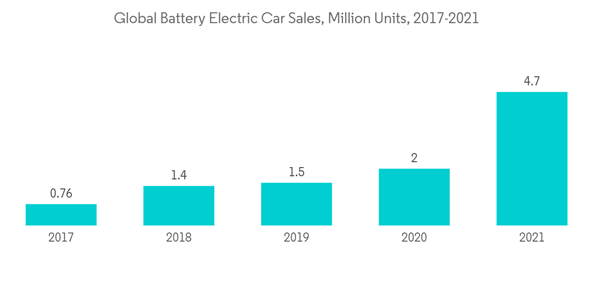Ethylene Carbonate – Market Share Analysis, Industry Trends & Statistics, Growth Forecasts to 2029: Rising Demand for Lithium Batteries & Electric Vehicles
Ethylene Carbonate - Market Share Analysis, Industry Trends & Statistics, Growth Forecasts to 2029: Rising Demand ... Yahoo Finance


Company Logo

Ethylene Carbonate Market Global Battery Electric Car Sales Million Units 2017-2021


Introduction
Dublin, March 13, 2024 (GLOBE NEWSWIRE) — The “Ethylene Carbonate – Market Share Analysis, Industry Trends & Statistics, Growth Forecasts 2019-2029” report has been added to ResearchAndMarkets.com’s offering.
The Ethylene Carbonate Market size is estimated at USD 1.03 billion in 2024, and is expected to reach USD 1.63 billion by 2029, growing at a CAGR of 9.58% during the forecast period (2024-2029).
Ethylene Carbonate Market Impact of COVID-19


Ethylene carbonate output and consumption have been affected by COVID-19. Due to lockdowns, production limits, and global economic recession, ethylene carbonate and other chemical demands have slowed. Ethylene carbonate and other chemicals are cheaper due to lower demand. After the pandemic, the ethylene carbonate demand increased because of lithium-ion batteries for electric cars and systems that store energy from renewable sources.
Key Highlights
-
The ethylene carbonate market grew recently. With the increase in demand for electric vehicles (EV) and device manufacturing units, there is an increase in lithium battery and lithium consumption, resulting in positive growth for the ethylene carbonate market.
-
Over the medium term, the factors affecting the ethylene carbonate market growth include the rising number of applications for intermediates in the chemical sector and the growing need for lithium batteries in the automobile sector.
-
However, on the flip side, rising health hazards due to the toxicity of ethylene carbonate and replacement prospects by other substitutes are expected to hinder the market’s growth.
-
Asia-Pacific is expected to dominate the global market due to its highly developed electronics sector and high production of lithium-ion batteries.
SDGs, Targets, and Indicators Analysis
1. Which SDGs are addressed or connected to the issues highlighted in the article?
- SDG 7: Affordable and Clean Energy
- SDG 9: Industry, Innovation, and Infrastructure
- SDG 11: Sustainable Cities and Communities
- SDG 12: Responsible Consumption and Production
- SDG 13: Climate Action
- SDG 17: Partnerships for the Goals
The article discusses the growth of the ethylene carbonate market due to the increasing demand for lithium batteries, particularly in electric vehicles. This aligns with SDG 7, which focuses on ensuring access to affordable, reliable, sustainable, and modern energy for all. It also relates to SDG 9, which aims to build resilient infrastructure, promote inclusive and sustainable industrialization, and foster innovation. Additionally, the article mentions the impact of ethylene carbonate on sustainable cities and communities (SDG 11), responsible consumption and production (SDG 12), climate action (SDG 13), and partnerships for the goals (SDG 17).
2. What specific targets under those SDGs can be identified based on the article’s content?
- Target 7.2: Increase substantially the share of renewable energy in the global energy mix.
- Target 9.4: Upgrade infrastructure and retrofit industries to make them sustainable.
- Target 11.6: Reduce the adverse per capita environmental impact of cities.
- Target 12.2: Achieve sustainable management and efficient use of natural resources.
- Target 13.2: Integrate climate change measures into national policies, strategies, and planning.
- Target 17.16: Enhance the global partnership for sustainable development.
The article indirectly addresses these targets by highlighting the growth of the ethylene carbonate market, which is driven by the demand for lithium batteries in electric vehicles. This growth contributes to the increased share of renewable energy, sustainable infrastructure and industries, reduced environmental impact of cities, efficient use of natural resources, integration of climate change measures, and global partnerships for sustainable development.
3. Are there any indicators mentioned or implied in the article that can be used to measure progress towards the identified targets?
- Indicator 7.2.1: Renewable energy share in the total final energy consumption
- Indicator 9.4.1: CO2 emission per unit of value added
- Indicator 11.6.1: Proportion of urban solid waste regularly collected and with adequate final discharge
- Indicator 12.2.1: Material footprint, material footprint per capita, and material footprint per GDP
- Indicator 13.2.1: Number of countries that have communicated the establishment or operationalization of an integrated policy/strategy/plan
- Indicator 17.16.1: Number of countries reporting progress in multi-stakeholder development effectiveness monitoring frameworks
The article does not explicitly mention these indicators, but they can be used to measure progress towards the identified targets. For example, the renewable energy share in the total final energy consumption (Indicator 7.2.1) can be used to assess the increase in renewable energy as a result of the growth in the ethylene carbonate market. Similarly, indicators such as CO2 emissions, waste management, material footprint, and integrated policy/strategy/plan implementation can provide insights into the sustainability and environmental impact of the ethylene carbonate industry.
Table: SDGs, Targets, and Indicators
SDGs Targets Indicators SDG 7: Affordable and Clean Energy Target 7.2: Increase substantially the share of renewable energy in the global energy mix. Indicator 7.2.1: Renewable energy share in the total final energy consumption SDG 9: Industry, Innovation, and Infrastructure Target 9.4: Upgrade infrastructure and retrofit industries to make them sustainable. Indicator 9.4.1: CO2 emission per unit of value added SDG 11: Sustainable Cities and Communities Target 11.6: Reduce the adverse per capita environmental impact of cities. Indicator 11.6.1: Proportion of urban solid waste regularly collected and with adequate final discharge SDG 12: Responsible Consumption and Production Target 12.2: Achieve sustainable management and efficient use of natural resources. Indicator 12.2.1: Material footprint, material footprint per capita, and material footprint per GDP SDG 13: Climate Action Target 13.2: Integrate climate change measures into national policies, strategies, and planning. Indicator 13.2.1: Number of countries that have communicated the establishment or operationalization of an integrated policy/strategy/plan SDG 17: Partnerships for the Goals Target 17.16: Enhance the global partnership for sustainable development. Indicator 17.16.1: Number of countries reporting progress in multi-stakeholder development effectiveness monitoring frameworks Behold! This splendid article springs forth from the wellspring of knowledge, shaped by a wondrous proprietary AI technology that delved into a vast ocean of data, illuminating the path towards the Sustainable Development Goals. Remember that all rights are reserved by SDG Investors LLC, empowering us to champion progress together.
Source: finance.yahoo.com

Join us, as fellow seekers of change, on a transformative journey at https://sdgtalks.ai/welcome, where you can become a member and actively contribute to shaping a brighter future.







